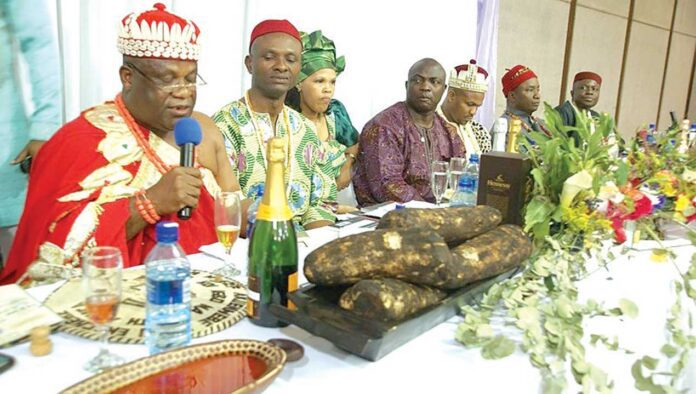People may wonder about the origins of the New Yam Festival. In Igbo land, the yam represents a human – Ahiajoku, who was sacrificed so that other humans may live. The new yam festival symbolizes the conclusion of a harvest and the beginning of the next work cycle.
Ahiajoku is the ultimate example of a human hero. She is honoured in Igbo mythology since her spirit became the God of yam.
Click to read more about Ahiajoku, the God of Yam
Yam is one of the main agricultural crops and food of the Igbos. Yams are among the first set of crops to be planted at the beginning of every planting season. The planting season is usually between the months of April and August.
A lot is dependent on its survival throughout the harvest season; because it could be influenced by a wide range of religious forces, from ancestors to gods. As a result, it is important that these powers be treated with respect. It is also being presented as special prayers and sacrifices during the yam harvest.
The history of the New Yam Festival makes it the most significant festival among the Igbos of South-eastern Nigeria. The New Yam Festival is a celebration that shows the prominence of yam in the social-cultural life of the people.
When a is the New Yam Festival celebrated?
New yam festival is called Iwa ji/Iri ji/Ike ji in Igbo language. Iwa ji/Iri ji/Ike ji as it is called by different dialects in Igbo is an annual cultural festival. The New Yam Festival held at the end of a rainy season literally means the “eating of yam”.
The festival is held by all communities in the Igbo land. It is also internationally recognized and observed by the Igbos in the Diaspora across the world.
The New Yam Festival is also practised amongst other tribes in West Africa as accustomed to their beliefs.
What happens in New yam festival?
For example in Anambra State communities; the people offer thanksgiving to their gods and ancestors for guiding them all through the farming season.
There are also cultural displays at the event like the masquerades and the local dancers including women, children and men dancers. The festive also includes the performance of rites by the Igwe or the eldest man in the community.
The festival features Igbo cultural activities in the form of contemporary shows, masquerade dances, and fashion parades. These functionalities add meaning to the New Yam Festival.
In some communities, the celebration lasts a whole day, while in other places it could take a week or more.
Download Chinua Achebe Things Fall Apart; to learn more about the role of Yam farming in Ancient Igbo and African Culture
Rites of the New Yam Festival
Although, the style may differ from one community to the next, the essential components of the festival remain the same. Some of the common rites in most Igbo communities are:
- On the eve of the Festival, all old yams from the previous year’s crop must be eaten or discarded.
- At the beginning of the festival, the yams are offered to the gods first before distributing them to the villagers. The ritual is performed either by the oldest man in the community or by the king or eminent titleholder. It is accompanied by merriments and so much more.
- After the prayer of thanksgiving to God, the elders will eat the first yam. Only after then will the rest of the community consume the new yam without incurring the wrath of the gods. The yam is eaten with ‘mmanụ nri’ i.e red oil.
Click to learn more about the Igbo Calendar, AKA Izu Igbo
The king or eldest man is given the privilege of acting as the community’s intermediary between the gods and the people.
It is a taboo for any indigene of the community to eat new yam before the traditional ceremony.
In some communities, nobody is allowed to harvest his/her farm produce (especially Yam) before the festival.
If we missed something out, do well to drop a comment, like, share with friends.
